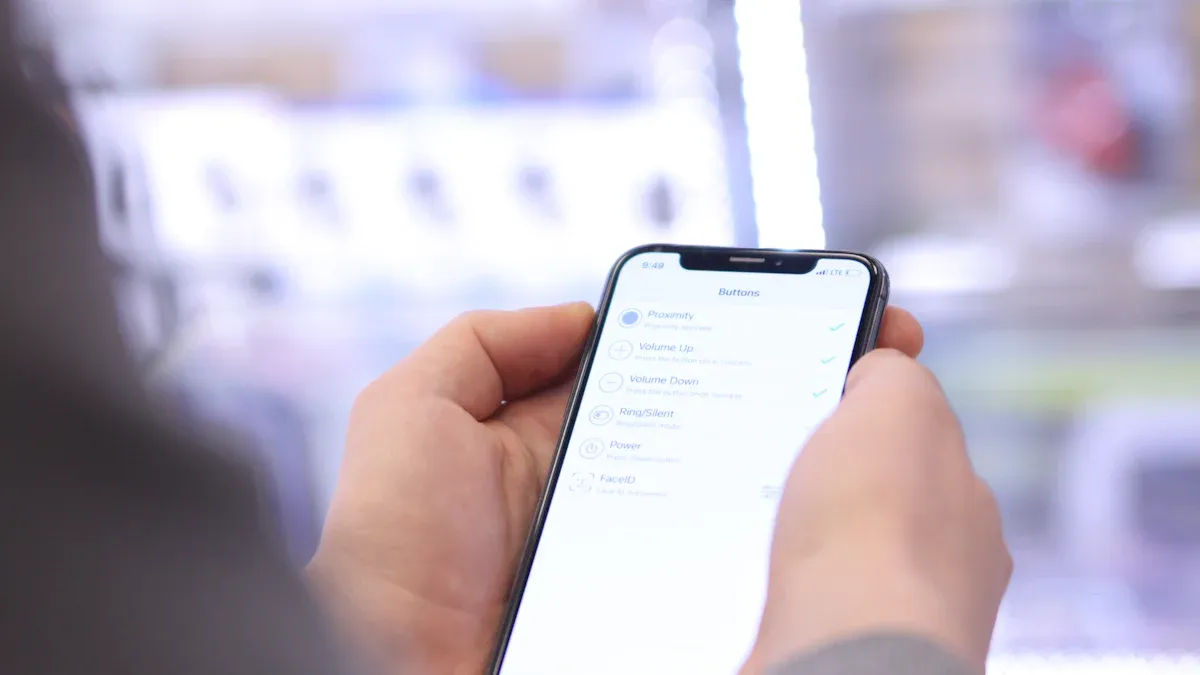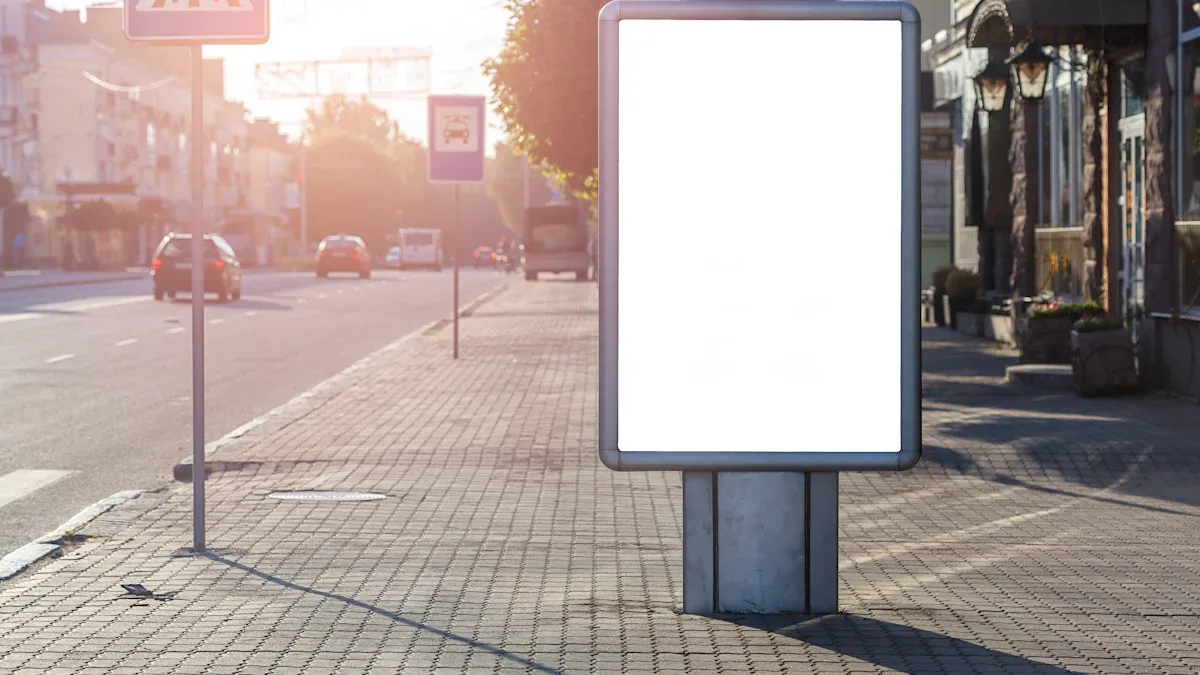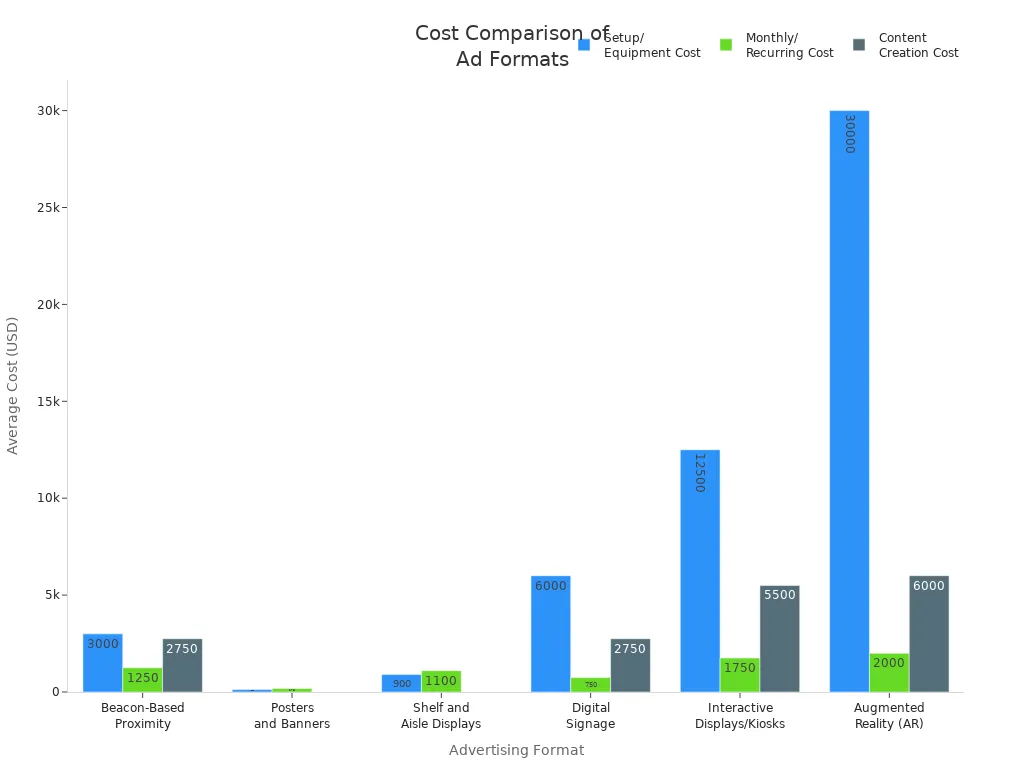
Location-triggered ads help businesses grow in a clear way. New data shows marketers often get more sales. Some campaigns give back all the money spent. In 2023, the world market for these ads was over $111 billion. This number keeps getting bigger fast. More people use smartphones and better location technology. Marketers look at things like conversion rates, engagement, and retention. These numbers help them see how well their ads work.
Key Takeaways
Location-triggered ads send messages based on where people are. They use GPS and beacons to reach customers at the right time and place. These ads help businesses grow by getting more people to visit stores. They also boost sales and help customers connect with special offers made just for them. The market for location-triggered ads is growing very fast all over the world. There is strong demand in Asia Pacific, the Americas, and North America. Businesses get better results by focusing on certain areas. They use local language and send ads when customers are most likely to see them. Privacy is important. Companies must get user consent and follow laws to build trust and keep customers happy.
Location-Triggered Ads Overview

Definition
Location-triggered ads send messages to people based on where they are. Marketers pick an area, like around a store or inside a set zone. When someone enters that spot, they get ads or alerts. This uses GPS, geofencing, and geotargeting. Companies can send push notifications, texts, or deals through apps. For example, if you walk by a coffee shop, you might get a coupon on your phone.
Industry leaders say location-triggered ads help reach people at the best time. These ads use geospatial tools to match messages to where you are. Many brands use artificial intelligence and machine learning to study location data. This lets them send ads that fit each person better.
Note: Location-triggered ads only work if users agree to share their location. This keeps privacy safe and helps people trust the ads.
How They Work
Marketers use different tools to make location-triggered ads work:
Geofencing: Makes invisible lines around a place. When a device crosses it, an ad or alert pops up.
Beacons: Small Bluetooth gadgets in stores. They send signals to phones nearby for indoor targeting.
GPS, Wi-Fi, and Cellular Data: These help find where a user is, inside or outside.
Geotargeting: Reaches people using bigger location areas, like a city or neighborhood.
Marketers mix location data with other info, like what people buy or their age. This helps them make better ads. They use digital tools, geolocation APIs, and ad networks to send these ads. Businesses get more people interested, more store visits, and can see if online ads bring people to stores.
Tip: Always get user consent before using location data. This keeps ads fair and follows privacy rules.
Revenue Potential

Market Size
The world market for location-triggered ads is growing fast. Companies spend more money each year as tech gets better. More people use smartphones now. The table below shows how big the market is and what it might be later:
Metric | Value |
|---|---|
Market Size in 2024 | |
Projected Market Size in 2031 | USD 283.28 billion |
CAGR (2024 to 2031) | 14.8% |
Asia Pacific is growing the most. China, India, and Japan help this growth with more digital tools and lots of smartphone users. Brazil is important in the Americas. It has a 12.3% jump in ad spending. This happens because more people use digital things and more people have money to spend. North America has the biggest part of the market, but it is not growing as fast as other places.
Retail and e-commerce companies use these ads to find customers near their stores. This helps them sell more. Travel, hospitality, and transportation also use these ads. They send deals and messages based on where people are going. As more businesses use these ads, the market will keep getting bigger.
ROI Drivers
Businesses pick location-triggered ads because they get good results. Many things help make these ads work well:
Location intelligence helps marketers learn where customers go and what they like.
Real-time data from GPS, Wi-Fi, and Bluetooth lets ads reach people at the best time.
Companies can see which places work best and change their plans fast.
These ads help more people know about brands and make ads work better.
Geofencing and beacon devices help count how many people visit stores.
Important numbers that show ROI are:
More people buy things online and in stores
It costs less to get each customer
More people click on ads and pay attention
Ads reach more people in the right places
Almost 90% of brands using these ads say they sell more and get more customers. Over 70% of people will share their location if they get good deals or content. Marketers use location data to talk to people after events, which helps even more. Stores, restaurants, and service companies get more sales and better relationships with local people.
Note: Businesses using location-triggered ads can change their plans quickly. This makes every dollar spent work better.
Ad Effectiveness
Engagement Rates
Location-triggered ads work well because they reach people at the right time and place. Marketers use radius targeting and geo-fencing to find users near important spots. This makes the ads feel more local and gets people to act fast. For example, restaurants send ads to office workers at lunchtime. Stores show sales to people who live close by. These methods help more people see and click on ads.
When ads use local culture, landmarks, or familiar words, brands stand out more. People feel like the ad is talking just to them. This makes them more likely to click and care about the ad. Businesses notice more people coming in and using their deals.
Tip: Ads that fit local interests and habits get more attention and better results.
A restaurant used geo-fencing to reach office workers within one mile at lunch. This brought in 25% more people and boosted sales during slow times. A big retail chain used proximity targeting near stores on a holiday weekend. This led to a big jump in visits and sales. A fitness studio gave discounts to people living within 10 miles. More people signed up for memberships.
Conversion Impact
Location-triggered ads do more than just get noticed. They help turn interest into real sales. Advertisers who target people near key places or who visit often see more sales. Quick, local deals make people want to act right away. For example, if a shopper gets a discount near a store, they are more likely to go in and buy something.
Location-based ads use GPS, geofencing, and geotargeting to send special messages. By focusing on where people are or have been, ads feel more important. Personal messages that match local culture and habits help people trust the brand. This makes it more likely that people will visit or buy something.
Businesses also save money by showing ads to the right people. This means less money is wasted. Marketers check cost-per-acquisition (CPA) to see how much it costs to get each customer. For example, if a $500 campaign brings in 100 customers, the CPA is $5. Comparing what is earned to what is spent shows return on investment (ROI). If a $10,000 campaign makes $50,000 in sales, the ROI is 400%. Loyal customers make these ads even more valuable over time.
The table below shows different ad types and how well they work:
Advertising Format | Setup/Equipment Cost Range | Monthly/Recurring Cost Range | Content Creation Cost Range | Engagement & Effectiveness Highlights |
|---|---|---|---|---|
Beacon-Based Proximity Marketing | $1,000 – $5,000 (installation) | $500 – $2,000 (software) | $500 – $5,000 per campaign | High personalization and targeting; increases conversion rates and drives in-store sales; higher initial cost but better ROI potential |
Posters and Banners | $50 – $200 (production) | $50 – $300 (placement) | N/A | Low cost but static content; limited engagement; often ignored unless well placed |
Shelf and Aisle Displays | $300 – $1,500 (production) | $200 – $2,000 (placement) | N/A | Effective for impulse buys; costs can accumulate; less flexible than digital formats |
Digital Signage | $2,000 – $10,000 (equipment) | $500 – $1,000 (maintenance) | $500 – $5,000 per campaign | Dynamic, real-time updates; higher ROI than static ads; more engaging |
Interactive Displays/Kiosks | $5,000 – $20,000 (equipment) | $1,000 – $2,500 (maintenance) | $1,000 – $10,000 per campaign | High engagement; allows direct customer interaction; higher cost but potential for increased sales and loyalty |
Augmented Reality (AR) | $10,000 – $50,000 (development) | $1,000 – $3,000 (maintenance) | $2,000 – $10,000 per campaign | Very high engagement potential; immersive experiences; highest cost among formats |

Location-triggered ads often work better than other types in local areas. They get more people to notice and buy by showing the right offers at the right time. This helps businesses use their ad money wisely and keep customers coming back.
Business Advantages
Customer Relevance
Location-triggered ads help brands talk to customers in a better way. These ads use where people are right now to send special offers. People get these offers when they are most likely to use them. Regular digital ads use wide group data, but location-triggered ads are more personal. Brands can make ads that fit local habits and what people like. This makes each ad feel special.
Location-based ads use GPS, Bluetooth beacons, and Wi-Fi to send ads to the right spot.
They give offers at the best time, so more people pay attention.
The ads change to match local events and what customers need.
Big brands like Starbucks and McDonald’s saw more people notice and buy with these ads.
Tip: Ads that are personal and on time make customers happier and help brands see if their ads work.
In-Store Traffic
Location-triggered ads help bring more people into stores. When people get good offers near a store, they want to visit. Studies show people who have been to a place before like ads about that spot more. Knowing a place makes ads feel right and makes visits more likely. For example, a study in Europe showed using revisit data can raise ad money by 26.1%.
GroundTruth, a top ad company, linked ad views to over 241,000 store visits with special ads. This shows that location-triggered ads really work for stores you can walk into.
Brand Growth
Location-triggered ads help brands grow and be remembered. Using the same look and local messages helps people know the brand. For example, a drink brand put ads at bus stops for six months and saw 40% more people remember them. People who saw these ads also spent 15% more over time.
Brands use interviews, quizzes, and QR codes to check how well ads work. Seeing the same logo and message many times builds trust and feelings for the brand. Location-based ads make sure the right people see them. This helps brands use their money well and stand out from others.
Challenges
Privacy Concerns
Location-triggered ads make people worry about privacy. Many people do not want to share their personal data with apps. They are afraid companies might track them or send ads that feel wrong. This can make people trust brands less.
Most people do not like sharing their personal data with apps. Less than 1% feel okay with it.
Many people have seen ads that made them feel bad. About 39% got ads they thought were rude or embarrassing.
When companies mix data from different places, people worry more. This can make them trust brands even less.
Some people know how to keep their data safe. They control what they share and often like ads made just for them.
Laws like GDPR in Europe and privacy tools from tech companies help people control their data. These rules help people trust brands again.
Note: Brands that are honest and let users control their data can build trust and loyalty.
Implementation
Businesses have some hard problems when starting location-triggered ads. They need strong systems to handle lots of data and send ads fast.
Companies must make sure their systems can handle many ad requests at once.
It should be easy to add or remove resources as needed.
Frequency capping is important. It stops the same ad from showing too much and saves money.
Reports must track events quickly and use detailed data.
Ad costs and views can be different on each platform, which can be confusing.
Good technology is important. Bad location data can waste ads and upset customers.
Using GPS, beacons, and apps together can be hard and cost a lot.
Businesses must follow different laws in each place, like GDPR or CCPA.
Tip: Checking systems often and having clear privacy rules help companies follow laws and keep things working well.
Best Practices
Targeting
Businesses get better results with location-triggered ads by using smart targeting. They pick “Presence” targeting to show ads only to people in the right area. This stops ads from being wasted and saves money. Companies also target places where customers live, work, or travel, not just their own address. Using local words in ads, like “Free Delivery in Dallas,” makes ads feel more special and gets more attention.
Leave out places that do not work well to save money.
Change bids for each place. Higher bids in good areas help get more sales.
Watch how each place does and change settings often to reach goals.
Marketers use data from foot traffic, browsing, and buying to make strong audience groups. They use up-to-date Points of Interest (POI) data every month to keep targeting correct. Adding POI polygons helps find real visitors, not just people passing by. Mixing location data with things like business hours makes ads even more focused.
Tip: Check and update location settings often. This helps you spend money wisely and reach the right people.
Creative Timing
Timing is very important for location-triggered ads. Marketers use weather and location triggers to show ads that fit what people need right now. For example, a hot soup ad on a cold night can help sell more. Real-time triggers, like sudden weather changes, make ads matter more and get more clicks.
Location-based ads get 45% more engagement than other ads.
78% of mobile searches with location lead to in-store buys.
Marketers send ads when people are most active. For example, they target night owls after normal hours. It is important to keep ads personal but also protect privacy so people trust the ads.
Performance Tracking
Good tracking helps businesses see how their ads are doing and make them better. They use tracking pixels, cookies, and special links with UTM codes to watch what users do. Tools like Google Analytics and Facebook Pixel give real-time info on visits, clicks, and sales. Other tools like SEMrush and HubSpot give even more details.
Important numbers to watch are impressions, click-through rate (CTR), cost per click (CPC), conversion rate, cost per acquisition (CPA), and return on ad spend (ROAS). Watching these numbers helps businesses know what works, fix their ads, and get the best results.
Note: Using one dashboard and auto-tagging makes tracking easier and helps improve ads.
Location-triggered ads work well and get more people to respond. They also help customers have a better experience. Businesses use data to make smart choices and help more people know their brand.
Advantages:
Easier to study the market
Money for ads is used better
Challenges:
People worry about privacy
Tech can cost a lot
Some ads might feel like spam
Experts say companies should use location data to help customers. They should send offers at the right time and try to earn trust. If companies plan well and care about privacy, they can do better in the digital world.
FAQ
What are location-triggered ads?
Location-triggered ads send messages to people based on where they are right now. Marketers use GPS, Wi-Fi, or beacons to send offers when someone enters a certain area. These ads help brands reach people at the best place and time.
How do location-triggered ads improve sales?
Brands get more sales because these ads target people near stores or events. The offers feel important, so customers act fast. Studies show these ads bring more people into stores and help more people buy things.
Are location-triggered ads safe for user privacy?
Brands must ask users before collecting location data.
Privacy laws like GDPR and CCPA protect people’s information.
Companies that follow these rules earn trust and keep data safe.
What industries benefit most from location-triggered ads?
Retail, restaurants, travel, and entertainment get the most benefits. These businesses use location data to send deals, bring in more visitors, and get people interested. Service companies also use these ads to reach local people and help more people know their brand.
See Also
How G37 Apple CarPlay Adapters Transform Your Driving Experience
Key Developments Influencing Wireless Android Auto Adapter Technology
Best Wireless Android Auto Adapters Reviewed And Compared For 2025
Reviewing The Best Wireless Apple CarPlay Adapters For Toyota RAV4
